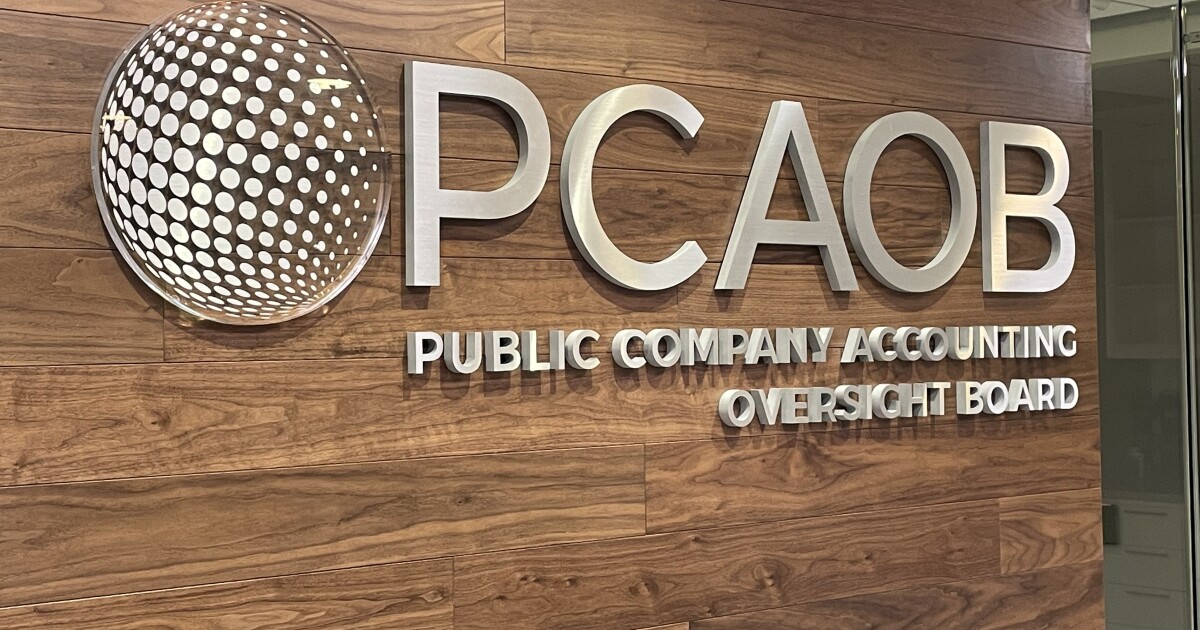The Public Company Accounting Oversight Board increased its enforcement activity in 2024 to its highest level since 2017, according to a new report, even as the PCAOB faces the prospect of perhaps being absorbed in the Securities and Exchange Commission.
The report, released Wednesday by Cornerstone Research, found that monetary penalties levied by the PCAOB reached their highest for the third consecutive year. The report also compares PCAOB enforcement activity under President Biden to President Trump’s first term.
The report found the PCAOB publicly disclosed 51 total enforcement actions, including 40 actions involving the performance of an audit. Most of these actions came in the first half of the year, with only 10 auditing actions finalized after the Supreme Court ruled against the use of administrative law judges in SEC v. Jarkesy. At $35.7 million, the number of total monetary penalties in 2024 marked a 78% increase over 2023 and represented nearly 40% of all monetary penalties imposed since the PCAOB’s inception.
“The PCAOB continued aggressive enforcement in 2024, finalizing 30 auditing actions in the first half of 2024, more than triple the number of actions finalized in the first half of 2023,” said Jean-Philippe Poissant, one of the report’s co-authors and co-head of Cornerstone Research’s accounting practice, in a statement. “In one in five auditing actions, the PCAOB alleged violations of not only auditing standards, but quality control standards and ethics and independence, as well.”
The report compares PCAOB enforcement under the Biden administration, and found that under the Biden administration, the PCAOB finalized 160 total actions, including 124 auditing actions, compared to 126 and 101, respectively, under the Trump administration. The total value of the monetary penalties imposed were nearly seven times higher during the Biden administration, reaching approximately $68 million, compared to just over $10 million during the first Trump administration.
“The type of respondents in enforcement actions shifted from a majority of individual respondents during the Trump administration to a near even split between individual and firm respondents during the Biden administration,” said Russell Molter, a principal at Cornerstone Research and report coauthor, in a statement. “Additionally, the percentage of respondents fined in Auditing Actions climbed from a little over half (59%) to nearly all respondents (94%).”
With 2024 marking the 20th year since the PCAOB finalized its first enforcement action, the report also analyzed the agency’s enforcement results in the past two decades. In these 20 years, the PCAOB finalized 487 total actions involving 675 respondents, the majority of which (344) were individuals. The PCAOB has imposed $94 million in monetary penalties since its inception.
Changes at the PCAOB and SEC
The report’s release coincides with new concerns over the future of the PCAOB under the Trump administration, which has been laying off thousands of federal employees as part of a cost-cutting initiative, while moving to all but close down agencies such as the Consumer Financial Protection Bureau and the U.S. Agency for International Development. The aggressive work of the PCAOB has occurred under PCAOB chair Erica Williams who was brought in by former SEC chair Gary Gensler with a mandate to get tougher on auditing firms and ramp up inspections, enforcement and standard-setting. The Heritage Foundation’s Project 2025 planning document that was circulated prior to Trump’s election called for the PCAOB to be abolished, along with the Financial Industry Regulatory Authority, and said their regulatory functions should be absorbed into the SEC.
Trump has nominated Paul Atkins, a former SEC commissioner who was previously critical of the PCAOB, as the next chair of the SEC. That could prompt another wave of turnovers at the board, as occurred during the previous Trump administration and the Biden administration.
“As it relates to the PCAOB and the SEC, I think there’s been a lot of projection, a lot of hypotheses or predictions that the PCAOB would be folded into the SEC based upon prior views of the administration or Chairman Atkins,” said Andrew Gragnani, president of CBIZ CPAs P.C. “That leads to a lot of questions regarding the nature and timing of inspections, the nature and timing of funding, etc. It does not change the need to continue to perform high-quality audits. We’re not planning that there will be wholesale changes to the inspection process. I don’t think that’s a healthy way to look at how this will all play out, but there are changes that people have projected that would impact firms. I think the primary one that people are focused on with the administration is the view that there’ll be less enforcement activity, so that obviously would be one that would be most significant to the firms, given that the PCAOB, under Chairman Williams, has been very active in their enforcement against firms for inspections. That might be the most meaningful change if there was to be this folding of the PCAOB into the SEC. That’s the one major expectation from the administration that has been anticipated.”
Dan Goelzer, one of the original members of the PCAOB and later an acting chair, recently told Accounting Today that a change in the composition of the board is likely.
“I suppose it’s probably pretty likely that there will be maybe a complete change in the membership of the board,” said Dan Goelzer, one of the original members of the PCAOB and later an acting chair. “That happened both of the last times around when there was a change in administration. I don’t really say that with any pleasure. I’d rather see a less political PCAOB. But as a practical matter, I certainly think the new SEC would look to change the chair of the PCAOB — I suppose that’s quite likely at least — and some of the other board members as well.”
There may be a restructuring of the PCAOB as well, along with its possible absorption into the SEC. “The other big picture issue is whether broad efforts to restructure or streamline the government are going to include the idea of folding the PCAOB into the SEC,” said Goelzer. “That came up during the prior Trump administration and was actually proposed in one of Trump’s budgets, and it’s in the Heritage Foundation report. I suspect that will come up as a discussion item, at least. Whether it would actually make it through Congress is far from clear.”
The SEC has overhauled the membership of the PCAOB under Gensler, and during the Trump administration under former SEC chair Jay Clayton, but there were some differences.
“I do think there’s a distinguishing factor with Jay Clayton in that most, if not all, of the PCAOB board members at that time were serving on expired terms, which was different from four years later, when Gary Gensler was the chair,” said Center for Audit Quality CEO Julie Bell Lindsay.
She believes effective oversight of the audit profession requires impartiality without political considerations. “The pendulum swinging back and forth every four years is not good,” said Bell Lindsay. “It’s not conducive for long-term audit quality. It’s not conducive to market efficiency and to stability of the capital markets. We would like to avoid the pendulum swinging every four years.”
She pointed out that both the SEC and the PCAOB have enforcement authority over auditors.
“With respect to enforcement over the public company audit profession, there are two cops on the beat,” said Bell Lindsay. “Both the PCAOB and the SEC have enforcement authority when it comes to public company auditors. Where there are bad actors, bad actors need to be held to account. The pendulum has swung pretty far in one direction, and there have been some concerns about the impact of the current enforcement thinking when it comes to retention of talent in the audit profession. This is not a profession that is necessarily bursting at the seams with new talent coming in, so the impact on talent and on public company audit firms wanting to stay in the business of auditing public companies. I think it’s really important to remember that at least 75% of the mid to small cap companies in the U.S. are serviced by mid to small size public company audit firms. A huge swath of the marketplace is serviced by small to mid sized public company auditors, and the impact that standard-setting, enforcement, etc can have on those firms can have unintended consequences.”
Goelzer is seeing similar concerns expressed at small auditing firms. “I’ve certainly heard people say that smaller firms are reconsidering whether they want to be engaged in public company auditing,” he said. “If you only have a handful of public company clients, you look at these penalties and the cost of complying with new auditing standards and regulations, firms may well conclude that they’ll simply leave this space and concentrate on private company auditing or other kinds of services for clients that has a spillover effect than on smaller public companies, which have less auditor choice, and probably increased audit fees as a result.”
The PCAOB board composition is likely to change at the very least. “If you think back to the previous administration, there was a complete overhaul of the board last time around, and we expect that there will be a similar reaction to the regime change,” said Jackson Johnson, president of Johnson Global Advisory, a Washington, D.C.-based firm that helps auditing firms navigate the PCAOB inspection process. “I do expect that the majority of the board will be replaced.”
He expects to see the SEC and the PCAOB taking a less aggressive stance and levying fewer penalties. “The current board’s priorities were to use enforcement as a regulatory tool, more standards and more enforcement,” said Johnson. “The next board will be quite different. The next board will be a more collaborative mindset with firms, more information gathering with stakeholders, more economic analysis to inform standard setting, more robust economic analysis to inform standard setting.”


 Economics1 week ago
Economics1 week ago
 Economics1 week ago
Economics1 week ago
 Economics1 week ago
Economics1 week ago
 Finance1 week ago
Finance1 week ago
 Blog Post1 week ago
Blog Post1 week ago
 Economics1 week ago
Economics1 week ago
 Personal Finance1 week ago
Personal Finance1 week ago
 Economics1 week ago
Economics1 week ago












